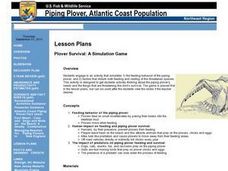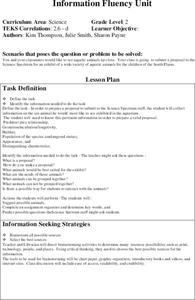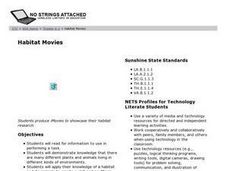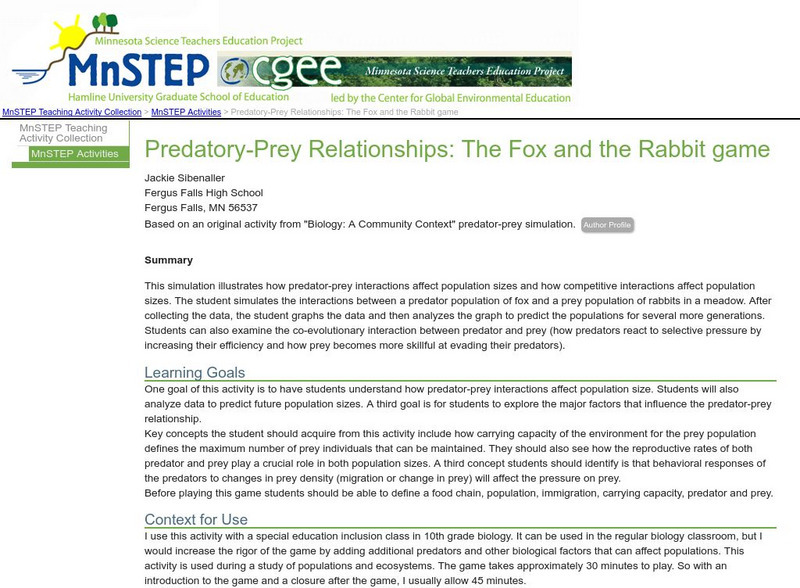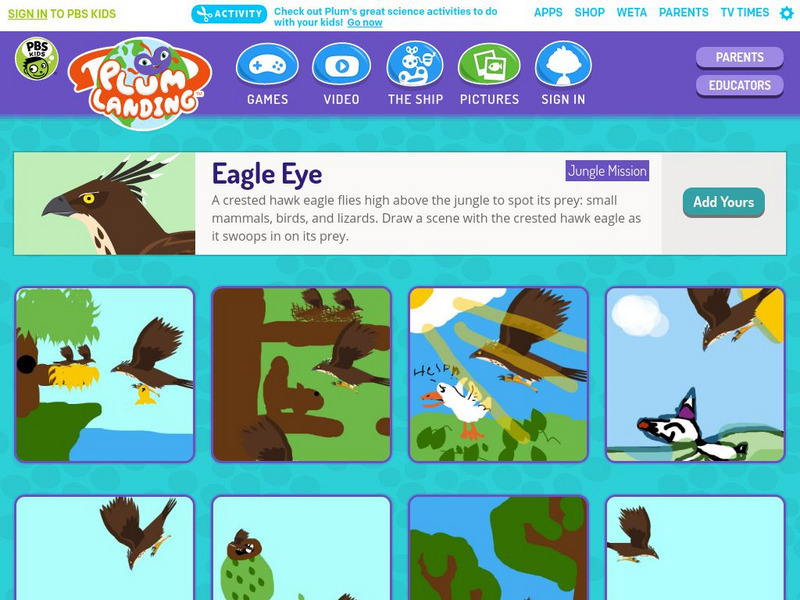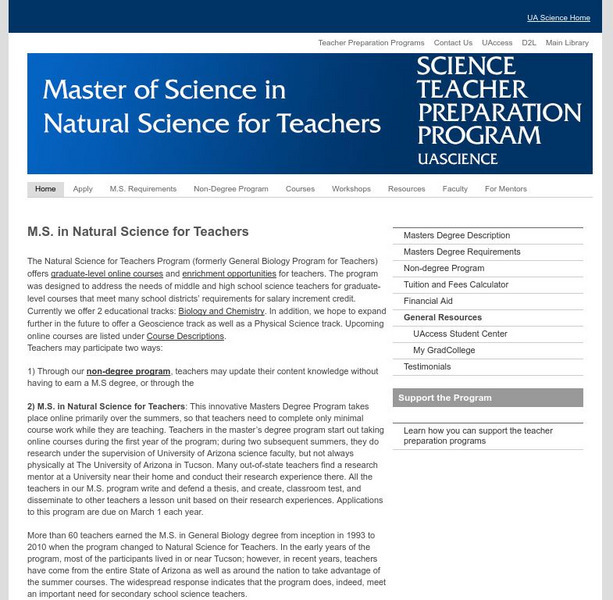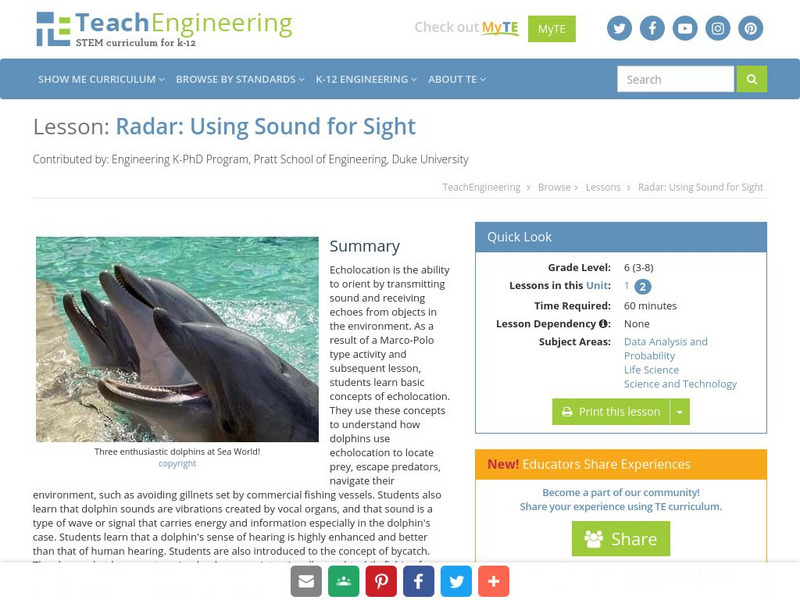Curated OER
Symmetry in Butterflies
Students create a butterfly displaying a mirror image of itself to show that it is symmetrical. In this symmetry lesson plan, students go over symmetry in different shapes and identify patterns in butterflies.
Curated OER
Plover Survival: A Simulation Game
Seventh graders engage in a simulation that explains the feeding behavior of the piping plover and the things that disturb the feeding and nesting of this species.
Curated OER
Animals of Point Reyes
Seventh graders explore how disasters affect animals. In this animal habitats lesson students create an animal that will survive in Point Reyes habitats.
Curated OER
The Great Spider Debate
Students study about the survival and hunting strategies of several different kinds of spiders. They also be introduced to scientific classification of spiders and write a brief report about one of the spider families they observe.
Curated OER
Creating a Freshwater Ecosystem
Students correctly identify some fishes of Texas and parts of their ecosystem.
Curated OER
Information Fluency Unit
Second graders create a proposal for the Science Spectrum to have an exhibit of a wide variety of aquatic animals for the children of the South Plains. These students would like to see aquatic animals up close.
Curated OER
Endangered Species Furniture Project
Students work in groups to research an endangered species. They then refinish and paint a piece of furniture and incorporate facts and references about the animal they have researched.
Curated OER
Amazing Bird Adaptions--Why Am I A Bird?
Fourth graders identify and classify birds found in Illinois. Using the internet, they discover how birds have adapted over time and how the adaptations have increased their life span. They compare and contrast the various adaptations...
Curated OER
I Will Survive!
The students will be given approximately five minutes to individually brainstorm general plant and animals adaptations that they already know about. The class will use these as a starting point to develop a KWL chart specific to desert...
Curated OER
Habitat Movies
Students create movies of various habitats and animals using their knowledge of the subject and the computer program iMovie. Emphasis is placed on cooperative learning and research.
Curated OER
Food Webs
Fourth graders discover how organisms depend upon each other in an ecosystem. In this ecosystems instructional activity, 4th graders use food webs to discuss the interdependence between organisms in an ecosystem.
Science Education Resource Center at Carleton College
Serc: Predatory Prey Relationships: The Fox and the Rabbit Game
This activity helps students understand how predator-prey interactions affect population sizes and how competitive interactions affect population sizes. They will also explore the major factors that influence the predator-prey relationship.
Science Education Resource Center at Carleton College
Serc: Mn Step: The Flow of Energy: Balancing Ecosystems
A lesson outlining activities for a science unit where students can learn about the relationships and the flow of energy within an ecosystem. These include predator and prey, hosts and parasites, and consumers, producers, and decomposers.
Other
Biology at Shaw High School: What Do Living Things Need to Survive?
Discusses the interrelatedness of all living things and of ecosystems and biomes, and what organisms need to survive and to maximize the carrying capacity of an ecosystem. This explanation is followed by a series of activities including...
PBS
Pbs Kids: Plum Landing: Eagle Eye
This PBS Kids activity is an extension of a Plum Landing episode featuring crested hawk eagle in the jungle. Using the online tools, students will draw a crested hawk eagle swooping down to grab its prey.
University of Texas at Austin
Univ. Of Texas: Texas Memorial Museum: Creating a Freshwater Ecosystem [Pdf]
An activity where students create a mobile that represent a freshwater ecosystem that appears in nature. Requires Adobe Reader [PDF].
PBS
Pbs Kids: Plum Landing: Fence for a Fox
This PBS Kids activity is an extension of a Plum Landing episode featuring foxes in Australia. Students will learn basic information about these foxes. Students will also design a fence to protect chickens from these nonindigenous foxes.
PBS
Pbs Kids: Plum Landing: Link to the Lynx
This PBS Kids activity is an extension of a Plum Landing episode featuring the lynx. Students will learn basic information about the lynx; students will also use online drawing tools to design a scene with a lynx hunting for food.
PBS
Pbs Teachers:night Creatures of the Kalahari: Life in a Bottle
Understand that an ecosystem such as the Kalahari has a system of checks and balances to ensure that no species overpopulates and threatens the survival of other species. Chart a food chain and explore the balance between predator and prey.
National Geographic
National Geographic: Marine Food Webs
For this lesson, students learn about marine food webs and pyramids, and how energy flows through a marine ecosystem. They then research a marine organism and its role in a marine food web. The class pools their information to create a...
Science Education Resource Center at Carleton College
Serc: Food Chains: Nature's Restaurant
Students begin this lesson by making observations and recording evidence of the variety of living things in local nature site. Students use reference materials to research predators and food of the animals they observed, then illustrate...
University of Arizona
Univ. Of Az: Spiders: An Organism for Teaching Biology
Students capture spiders and then conduct various experiments to identify their spider, analyze its feeding rate, and discover its effect on populations of insects. Includes directions for student activities and teaching tips.
TeachEngineering
Teach Engineering: Sound for Sight
Echolocation is the ability to orient by transmitting sound and receiving echoes from objects in the environment. As a result of a Marco-Polo type activity and subsequent lesson, students learn basic concepts of echolocation. They use...
Other
Ohio Dept. Of Education: Our Grasslands
This excellent unit of study for Grade Two has students examining what makes up a grasslands environment, growing their own grass, playing a predator-prey game, and looking at how grasslands are impacted by human activities.

